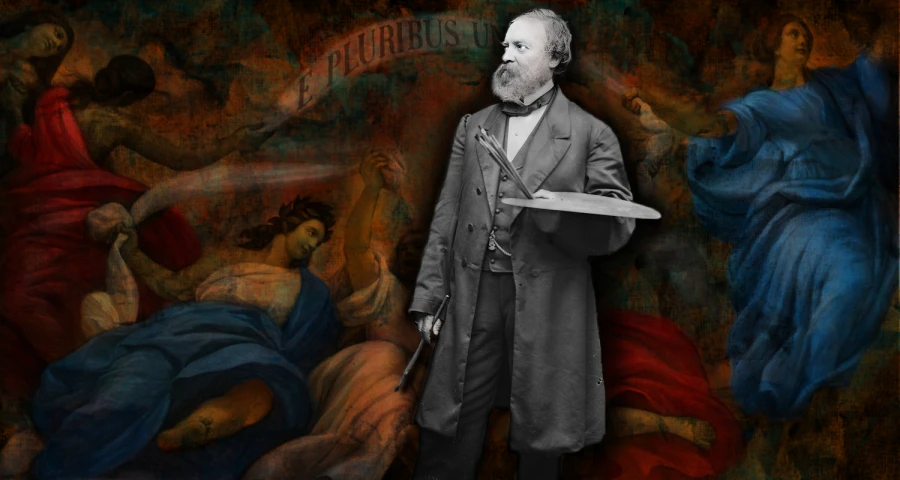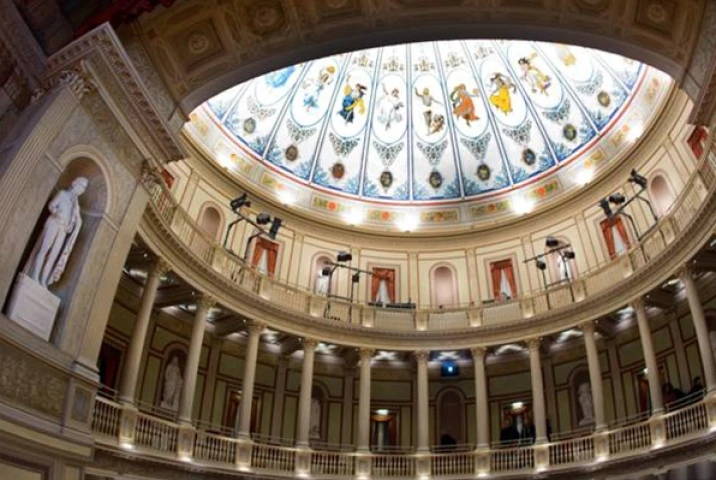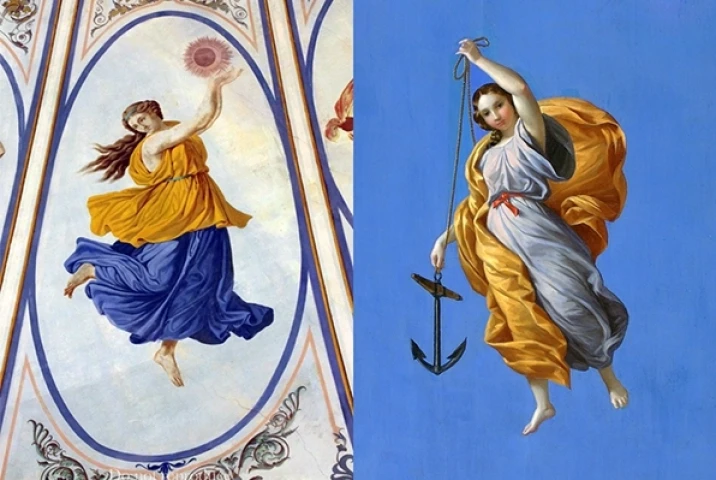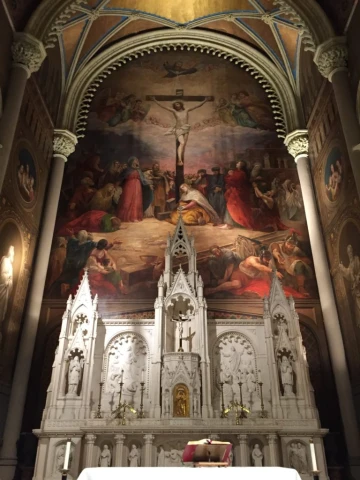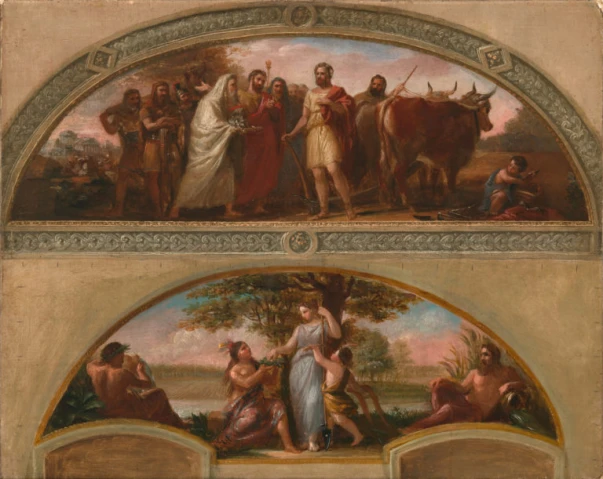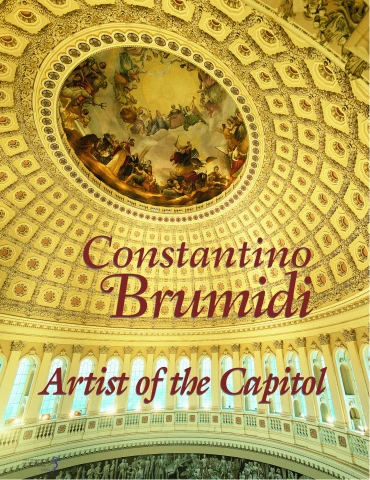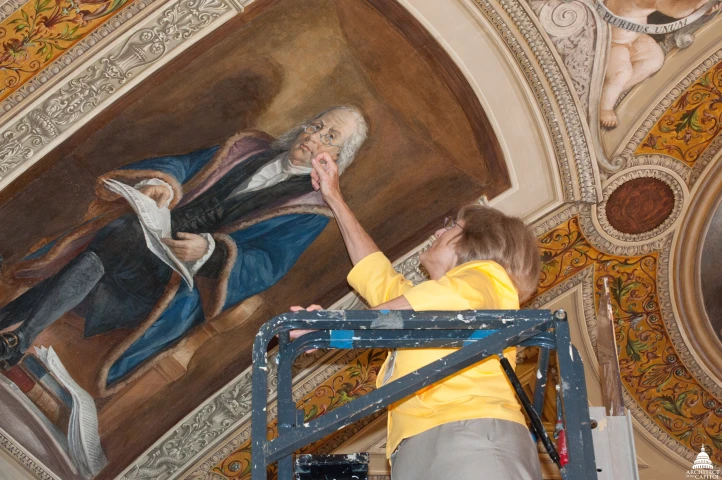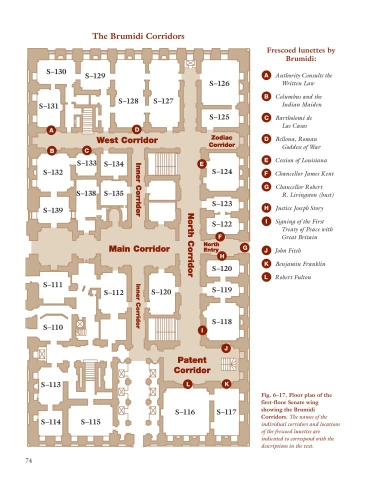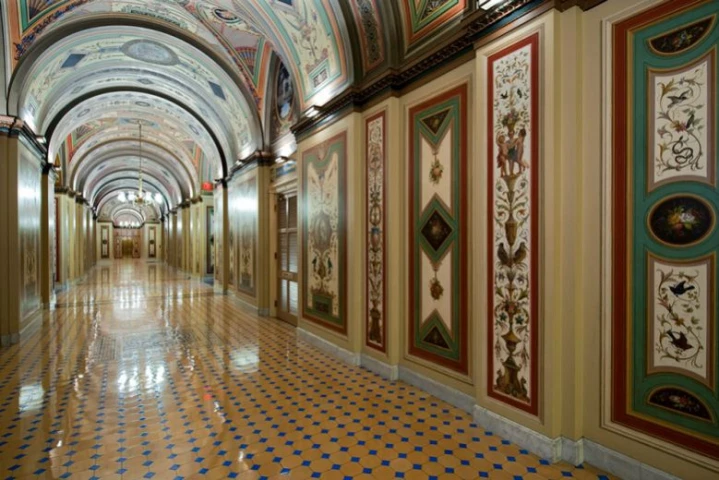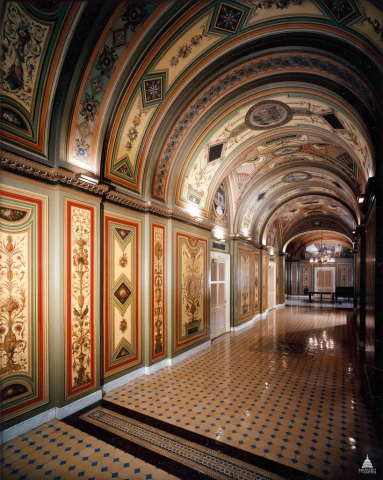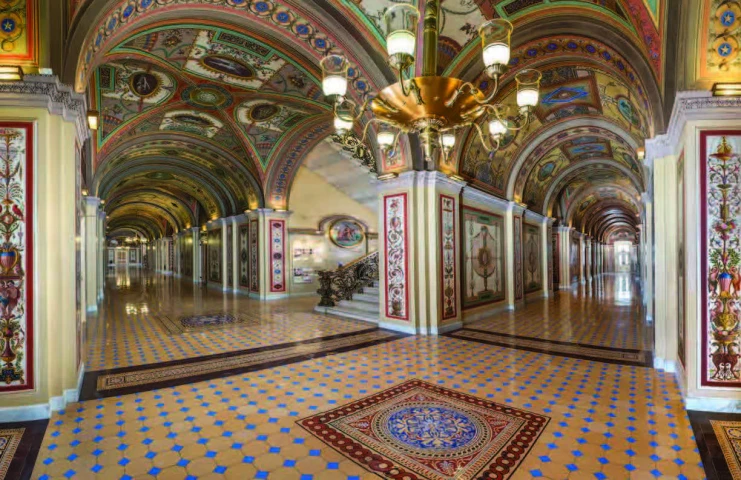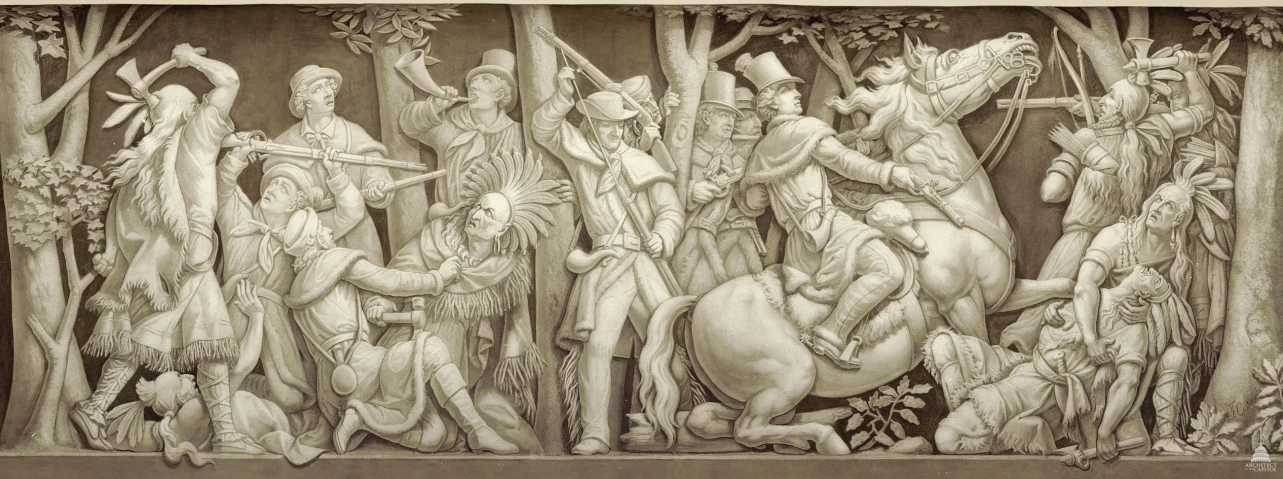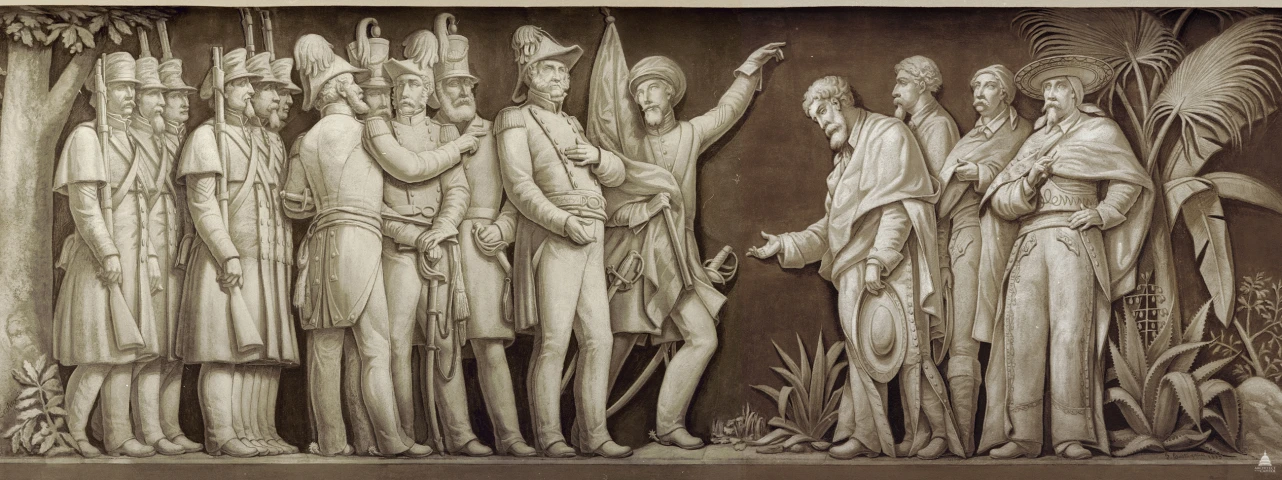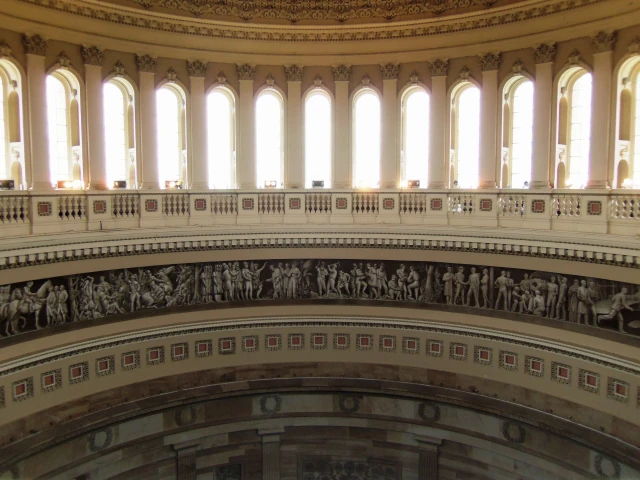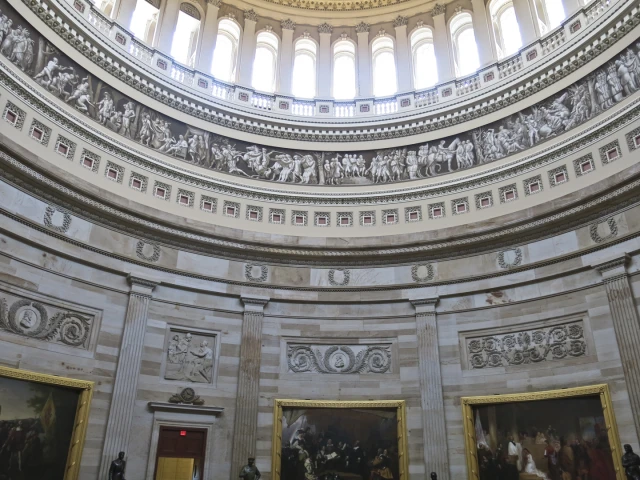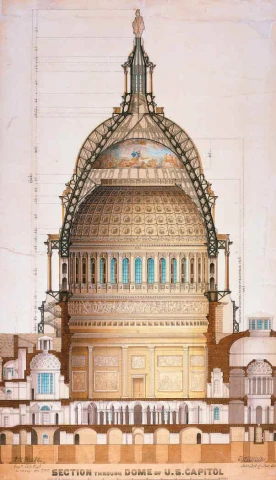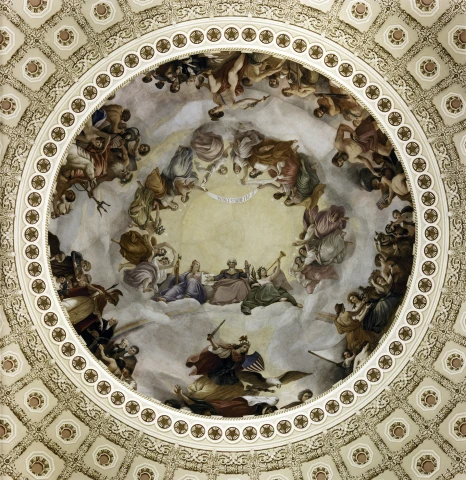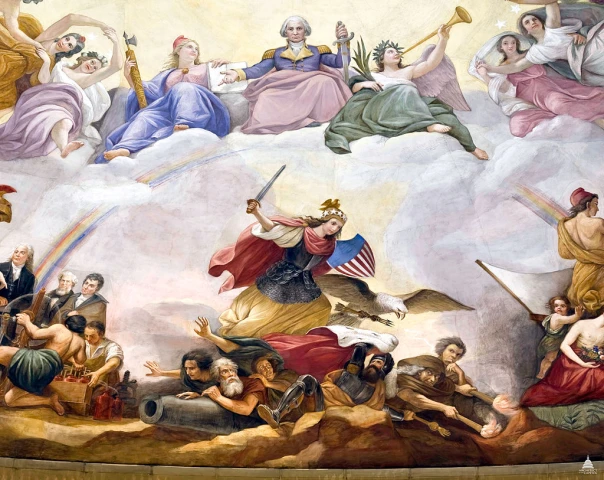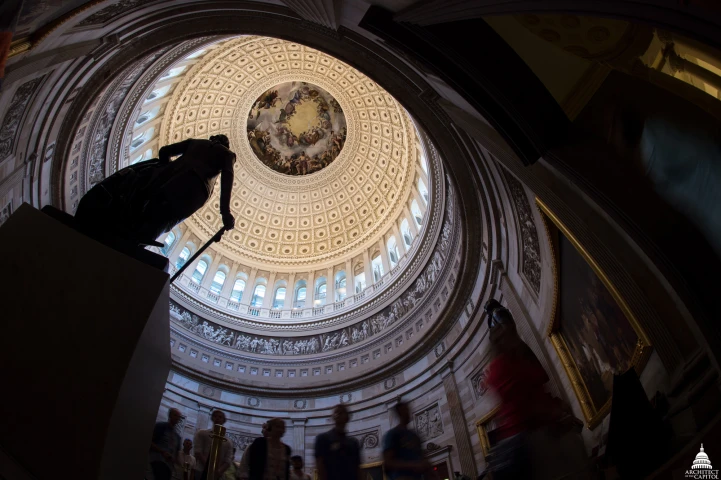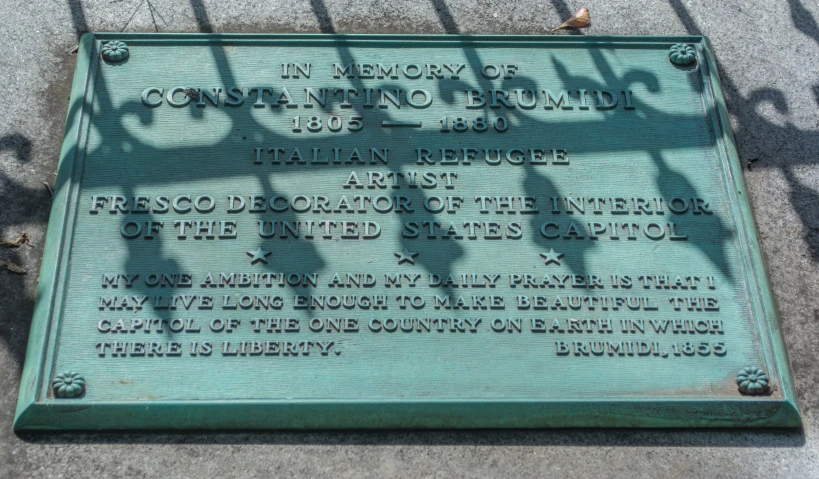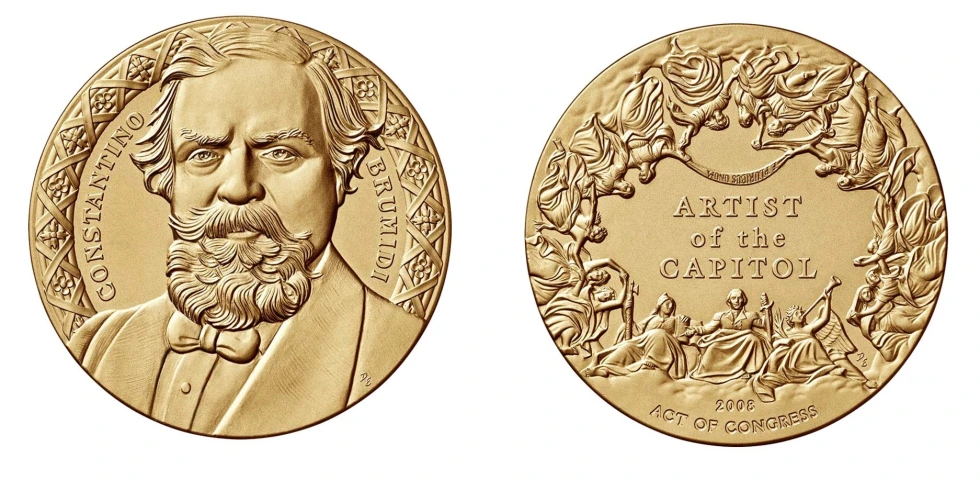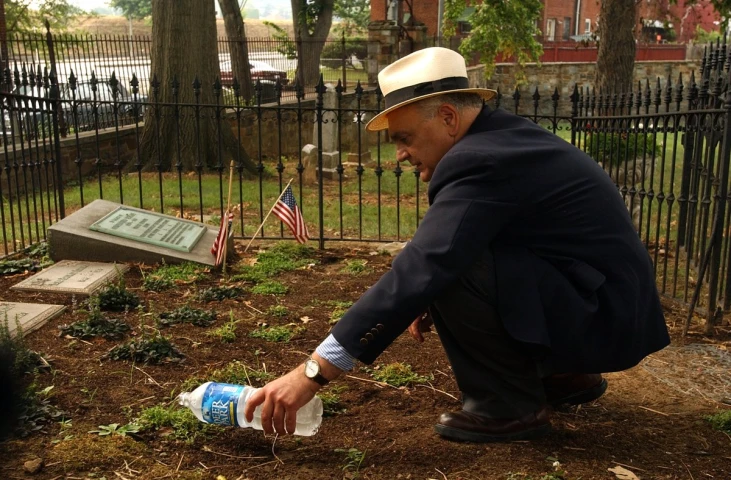When a fellow Italian like Constantino Brumidi gets to be called the “Michelangelo of the Capitol”, the readers of We the Italians understand that this is one of the topic that deserve to be addressed in an interview. This is why we are honored and grateful to have with us Dr. Barbara Wolanin, Ph.D. in art history, Curator Emerita (from 1985 to 2015) for the “Architect of the Capitol”, the builder and steward of the landmark buildings and grounds of Capitol Hill in Washington DC.
Dr. Wolanin was hired to oversee the conservation of Brumidi’s frescoes among many other important projects. Each year over her thirty years, another area of Brumidi’s murals were restored to their original beauty, with many rooms still left for her successor. Welcome Dr. Wolanin, and thanks for promoting and preserving Brumidi’s art
Dr. Wolanin, first of all: who was Constantino Brumidi?
Constantino Brumidi was an outstanding artist who created important murals in both Rome and America. He was born in 1805 in Rome. He started to show his talent at the Accademia di San Luca” when he was only thirteen years old. After fourteen years of training, he started working for big commissions and was considered one of the best painters in Rome. He worked for the Vatican and for the Torlonia family, particularly for Alessandro Torlonia. He was in charge of all of the original murals in the Theatre in the Villa Torlonia.
He ended up getting involved in the Roman Republican Revolution, because he was a Captain in the Civic Guard permitted by Pope Pius IX. He tried to keep safe valuable things in a convent and monastery during the war. But after the Pope came back in power, he was arrested and accused of all kind of things, and kept in jail for over a year. There he stated that he wanted to leave and go to America, because at that time the United States had started building big churches and cathedrals and was being asked to wanted to paint artworks for them.
What were his first works, once arrived in America?
Soon after he got out of prison, he arrived in New York in 1852. He applied for American citizenship right away. He first took on private portrait commissions. He then went to Mexico City and painted a Holy Trinity for the cathedral, and then came to Washington DC and became his first paintings in 1855, when the new extension with two wings was built on the United States Capitol. He painted mostly on the Senate part of the Capitol, because the Senators were wealthier, they had been to Europe and they were more able to appreciate his work. After a new dome was approved by the Congress, he added monumental frescoes under it.
He painted the altarpiece for the Church of St. Stephen’s in New York, later returning to painted the Crucifixion above the high altar. He did many church commissions in addition his work at the Capitol and paintings for private homes.
Please, tell us something about Brumidi’s masterpieces in the Capitol
Brumidi worked almost full time for his first few years in the Capitol from 1855 to 1860 as the construction of the new wings was being completed. After that his work was more sporadic as there were no longer construction funds to draw on and Captain Montgomery Meigs who had the vision of murals in the Capitol was no longer there. But plans and ideas Brumidi has planned with Meigs continued to be carried out until his death.
There are two major public areas embellished with murals designed and executed or overseen by Brumidi: The Brumidi Corridors and the Rotunda. The system of corridors on the first floor of the Senate wing has been in recent years called the Brumidi Corridors, with the less decorated inner corridors included after testing and restoration of the original designs. The main corridors near the entry areas have wall panels and ceiling vaults decorated with complex designs inspired by Raphael’s Loggia in the Vatican. Brumidi combined classical settings and motifs with portraits and scenes from American Revolutionary and early history with landscapes, fruits, flowers, birds, animals and insects and new inventions flourishing in America and American patriotic symbols, a hymn of praise to his adopted country painting in brilliant color and intricate detail. He worked with a team of artists and decorative painters, painting the portraits, landscapes, and historical scenes himself.
When the Congress approved a new cast-iron dome over the Rotunda, Brumidi and Meigs planned “The Frieze of American History” and Brumidi prepared a detailed ink study in 1859, almost twenty years before he actually was on a scaffold and painting it in fresco in 1878. He was only able to complete about a third of the scenes before his death in 1880, but recommended another painter trained in Rome to complete his designs.
Because of a miscalculation by Meigs when giving the height of the scenes to Brumidi, the frieze he planned did not meet up as planned and it was only in 1953 that it was filled in by Allyn Cox with three additional scenes. What is remarkable about the frieze is how well Brumidi created the illusion of sculptural relief by painting in browns, blacks and whites, with his sure sense of how light falls on forms. The scenes start with Columbus Landing and ends with the Discovery of Gold in California.
The Apotheosis of Washington painted on the curved canopy over the Rotunda was probably planned by the Architect, Thomas U. Walter, who redesigned the dome to create a place for a monumental mural. The first president rises to the heavens, surrounded by allegorical figures and thirteen maidens representing the first states, all painting in rich and subtle color. On the ground below are six scenes, each with a Roman god or goddess, combined with figures from American history and the latest American technology. For example, Neptune and Venus are helping lay the Transatlantic Cable - which hadn’t even been completed when Brumidi was painting in 1865 at the end of the Civil War. He created an effective illusion of the heavens opening above all of the visitors who enter the Rotunda and over all the important ceremonies that happen there.
Both the Frieze and the Apotheosis were painted in true fresco, as were the historical portraits and scenes in the Brumidi Corridors. Captain Meigs searched for years for someone to paint frescoes in the Capitol, and Brumidi believed his were the first frescoes in America, painted on fresh plaster with deep knowledge of the requirements of the technique and with great confidence and joy in making the figures come alive.
Brumidi painted numerous other rooms and offices in the Capitol, include his first fresco in room H-144 painted for the House Agriculture Committee. Most of his murals are in the Senate wing because it was completed later and the Senators had greater appreciation for European styles. These include the President’s Room signed and dated 1860, the Naval and Military Affairs Committees now used by the Senate Appropriations Committee, and the Senate Reception Room.
Is it true that Brumidi's grave in Glenwood Cemetery was forgotten by everybody until 1952, when a bronze marker was set in place at the formerly unmarked grave?
The idea of marking his grave was spearheaded by Myrtle Cheney Murdock. She was the wife of a Congressman who gave tours on the Capitol. She got very interested in Brumidi and she published the first book on him in 1950. She was the one who found out where he was buried (in the family plot of the woman who was considered his American wife, even if they never get married), and Mrs. Murdock pushed to get the Congress to pass a law to provide the marker for his grave in the Glenwood Cemetery in Washington, DC.
Finally, in 2008 the US Government awarded the Congressional Gold Medal to Constantino Brumidi, now displayed in the Capitol Visitor Center, as part of an exhibit honoring him. Was the Italian American community instrumental in achieving this well deserved honor?
Yes, the Italian American community did lobby to have Brumidi recognized by the Congress, and was absolutely instrumental in the 2008 decision of the Government. In particular, I’d like to mention an Italian American who more than anybody else did any possible effort for this goal. His name was Joseph Grano, and he founded the Constantino Brumidi Society at the end of the 1990s. You would meet him gathering people to clean up Brumidi’s gravesite every year on the anniversary of his birth, or working with the United States Capitol Historical Society, lobbying as many members of the Congress he could to give Brumidi the Congressional Gold Medal. He was able to get the wonderful ceremony in the Capitol Rotunda to celebrate Brumidi anniversary in 2005 and saw the unusual posthumous gold medal on display. Unfortunately, he died in 2013.
Quando un connazionale italiano come Costantino Brumidi viene definito il "Michelangelo del Campidoglio", i lettori di We the Italians capiscono che questo è uno dei temi che meritano di essere affrontati in un'intervista. Per questo siamo onorati e grati di avere con noi la Dottoressa Barbara Wolanin, che ha un Ph. D. in storia dell'arte, Curatrice emerita (dal 1985 al 2015) per l'"Architect of the Capitol", l’istituzione che supervisiona e gestisce i simbolici edifici e tutta la zona del Campidoglio a Washington DC.
La Dottoressa Wolanin fu assunta con l’incarico di sovrintendere alla conservazione degli affreschi di Brumidi e di molti altri importanti progetti. Ogni anno, nel corso dei suoi trent'anni, una nuova area degli affreschi di Brumidi è stata restaurata alla loro bellezza originale, con molte stanze ancora lasciate per il suo successore. Diamo il benvenuto alla Dottoressa Barbara Wolanin, che ringraziamo per aver promosso e preservato l'arte di Brumidi
Dr.ssa Wolanin, prima di tutto: chi era Costantino Brumidi?
Costantino Brumidi è stato un artista eccezionale che ha creato affreschi importanti sia a Roma che in America. Nacque nel 1805 a Roma. Iniziò a mostrare il suo talento presso l'Accademia di San Luca quando aveva appena tredici anni. Dopo quattordici anni di formazione, iniziò a lavorare per grandi commissioni e crebbe fino ad essere considerato uno dei migliori pittori di Roma. Lavorò per il Vaticano e per la famiglia Torlonia, in particolare per Alessandro Torlonia. Fu responsabile di tutti gli affreschi originali nel Teatro di Villa Torlonia.
Finì per essere coinvolto nella Rivoluzione Repubblicana Romana, perché era un Capitano della Guardia Civica creata da Papa Pio IX. Cercò di mantenere al sicuro alcune preziose opere in un convento e monastero durante la guerra. Ma dopo il ritorno al potere del Papa, Brumidi fu arrestato e accusato di ogni genere di cose, e tenuto in prigione per oltre un anno. Lì dichiarò di voler partire e andare in America, perché a quel tempo gli Stati Uniti avevano iniziato a costruire grandi chiese e cattedrali e gli era stato chiesto di dipingere opere d'arte per loro.
Quali furono le sue prime opere, una volta arrivato in America?
Partì poco dopo essere uscito di prigione, e arrivò a New York nel 1852. Subito fece domanda per la la cittadinanza americana. Iniziò a lavorare con incarichi privati di ritrattistica. Poi andò a Città del Messico e dipinse una Santissima Trinità per la cattedrale, e poi venne a Washington DC e iniziò il suo primo dipinto nel 1855, quando fu costruita la nuova estensione a due ali del Campidoglio degli Stati Uniti. Dipinse per lo più nella parte del Senato, perché i Senatori erano più ricchi, erano stati in Europa e dunque erano maggiormente in grado di apprezzare il suo lavoro. Dopo l'approvazione di una nuova cupola da parte del Congresso, aggiunse monumentali affreschi al suo interno.
Dipinse la pala per la Chiesa di Santo Stefano a New York, e poi vi tornò a dipingere la Crocifissione sopra l'altare maggiore. Dipinse per molte commissioni ecclesiastiche, oltre al suo lavoro al Campidoglio, e fece anche dipinti per case private.
Ci racconta qualcosa sui capolavori di Brumidi in Campidoglio?
Brumidi lavorò quasi a tempo pieno nei suoi primi anni in Campidoglio, dal 1855 al 1860, mentre la costruzione delle nuove ali era in fase di completamento. Dopo il 1860 il suo lavoro divenne più sporadico, perché non c'erano più fondi a cui attingere e il Capitano Montgomery Meigs. che era stato colui che aveva avuto l’idea degli affreschi in Campidoglio, non c'era più. Ma i piani e le idee che Brumidi aveva progettato con Meigs continuarono ad essere realizzati fino alla sua morte.
Ci sono due grandi aree pubbliche impreziosite da affreschi progettati e realizzati o supervisionati da Brumidi: i Brumidi Corridors e la Rotunda.
Il sistema di corridoi al primo piano dell'ala del Senato è stato negli ultimi anni chiamato Brumidi Corridors, inclusi i corridoi interni meno decorate, dopo che furono restaurati i disegni originali. I corridoi principali nei pressi delle zone d'ingresso hanno pareti e volte a crociera decorate con disegni complessi ispirati alla Loggia di Raffaello in Vaticano. Brumidi combina ambientazioni e motivi classici con ritratti e scene della Rivoluzione Americana e della storia antica con paesaggi, frutti, fiori, uccelli, animali e insetti e nuove invenzioni che fioriscono in America e simboli patriottici americani, un inno di lode alla sua pittura di campagna adottata in colori brillanti e dettagli intimi. Brumidi lavorava con un team di artisti e pittori decorativi, mentre i ritratti, i paesaggi e le scene storiche venivano dipinte solo da lui.
Quando il Congresso approvò una nuova cupola in ghisa sopra la Rotonda, Brumidi e Meigs progettarono “The Frieze of American History” (Il Fregio della Storia Americana) e Brumidi preparò un dettagliato studio sull'inchiostro nel 1859, quasi vent'anni prima di salire su un'impalcatura e dipingerla ad affresco nel 1878. Fu in grado di completare solo circa un terzo delle scene prima della sua morte, avvenuta nel 1880, ma raccomandò un altro pittore formatosi a Roma per completare i suoi disegni.
A causa di un errore di calcolo da parte di Meigs nel dare l'altezza delle scene a Brumidi, il fregio che ha progettato non si completò come previsto, e fu solo nel 1953 che venne terminato da Allyn Cox con tre scene aggiuntive. Ciò che è notevole del fregio è come Brumidi abbia creato l'illusione di un rilievo scultoreo dipingendo in marrone, nero e bianco, con il suo sicuro senso di come la luce si diffonda nelle forme. Le scene iniziano con l'arrivo di Colombo e terminano con la scoperta dell'oro in California.
L'“Apotheosis of Washington” (Apoteosi di Washington) dipinta sul baldacchino curvo sopra la Rotonda fu probabilmente progettata dall'architetto Thomas U. Walter, che ridisegnò la cupola per creare un luogo per un affresco monumentale. Il primo Presidente sale al cielo, circondato da figure allegoriche e tredici fanciulle che rappresentano i primi stati, tutte dipinte con colori ricchi e sottili. Sul terreno sottostante ci sono sei scene, ognuna con un dio romano o una dea, in combinazione con figure della storia americana e con la più recente tecnologia americana. Per esempio, Nettuno e Venere stanno aiutando a posare il Cavo Transatlantico, che non era ancora stato completato quando Brumidi dipinse nel 1865, alla fine della guerra civile. Brumidi creò un'efficace illusione di apertura del cielo, soprattutto per i visitatori che entrano nella Rotonda e per tutte le importanti cerimonie che vi si svolgono.
Sia il Fregio che l'Apoteosi furono dipinti in veri affreschi, così come i ritratti e le scene storiche dei Brumidi Corridors. Il capitano Meigs cercò per anni qualcuno che dipingesse affreschi nel Campidoglio, e Brumidi credeva che i suoi fossero i primi affreschi in America, dipinti su intonaco fresco con profonda conoscenza dei requisiti della tecnica e con grande fiducia e gioia nel far rivivere le figure.
Brumidi dipinse numerose altre stanze e uffici nel Campidoglio, tra cui il suo primo affresco nella stanza H-144, dipinto per la Commissione Agricoltura della Camera. La maggior parte dei suoi affreschi sono nell'ala del Senato perché fu completata più tardi e, come detto, perché i Senatori potevano avere un maggiore apprezzamento per gli stili europei. Le opera di Brumidi si trovano nella Sala del Presidente - firmata e datata 1860, nelle Commissioni per gli affari navali e militari, ora utilizzate dalla Commissione per gli stanziamenti del Senato, e nella Sala di ricevimento del Senato.
È vero che la tomba di Brumidi, nel cimitero di Glenwood, è stata dimenticata da tutti fino al 1952, anno in cui venne collocata una placca in bronzo sulla tomba precedentemente anonima?
L'idea di segnalare con una placca la sua tomba fu di Myrtle Cheney Murdock. Era la moglie di un membro del Congresso che organizzava visite presso il Campidoglio. Si interessò molto a Brumidi e pubblicò il primo libro su di lui nel 1950. Fu lei a scoprire dove era stato sepolto (nella tomba di famiglia della donna che venne stata considerata la sua moglie americana, anche se non si sposarono mai ufficialmente), e la signora Murdock fece pressioni affinché il Congresso approvasse una legge per collocare una placca sulla sua tomba nel cimitero di Glenwood, a Washington DC.
Infine, nel 2008 il Governo degli Stati Uniti ha assegnato la medaglia d'oro al Congresso a Costantino Brumidi, ora esposta al Capitol Visitor Center, nell'ambito di una mostra che lo ha onorato. La comunità italo americana ha contribuito al raggiungimento di questo meritato obiettivo?
Sì, la comunità italoamericana ha insistito molto per ottenere il riconoscimento di Brumidi da parte del Congresso, ed è stata assolutamente determinante nella decisione del Governo del 2008. In particolare, vorrei citare un italoamericano che più di ogni altro ha fatto ogni sforzo possibile per questo obiettivo. Si chiamava Joseph Grano e fondò la Costantino Brumidi Society alla fine degli anni Novanta. Lo si poteva incontrare mentre radunava persone per ripulire la tomba e la placca di Brumidi presso il cimitero di Glenwood, ogni anno nell'anniversario della sua nascita; o lavorando insieme alla United States Capitol Historical Society, per spingere tutti i membri del Congresso al fine di conferire a Brumidi la medaglia d'oro del Congresso. Nel 2005 potè assistere alla meravigliosa cerimonia presso la Rotunda per il Brumidi anniversary e potè ammirare la medaglia d'oro postuma. Purtroppo, Joseph Grano è morto nel 2013.


